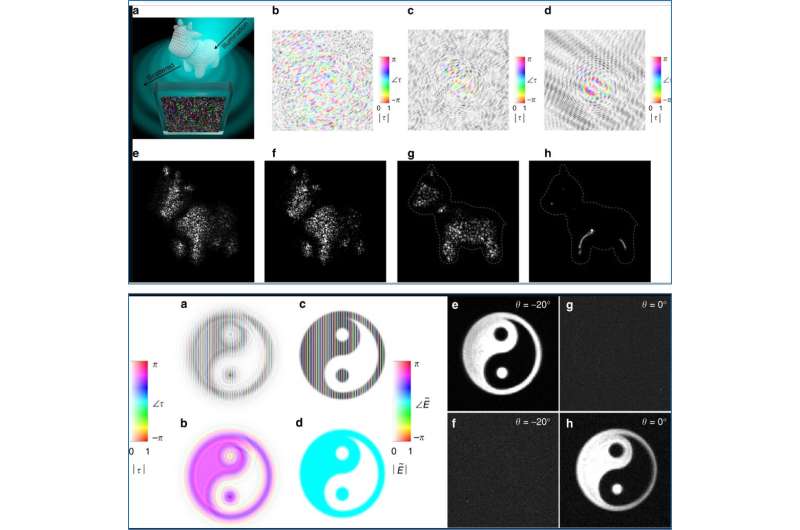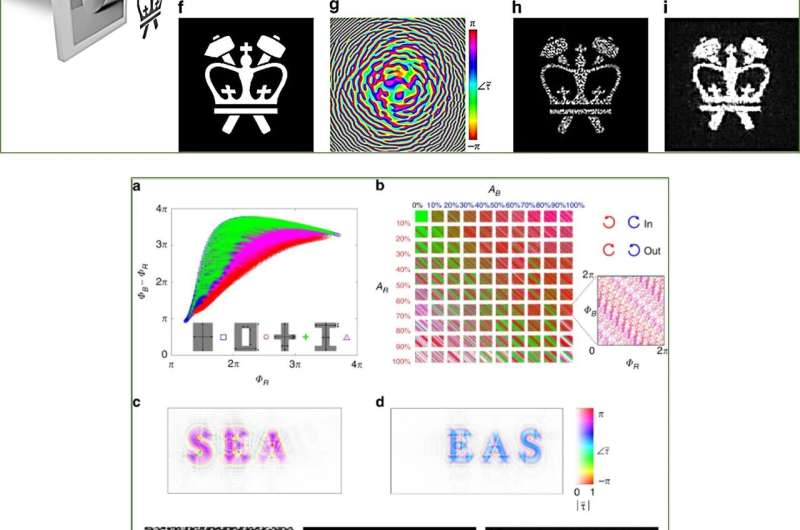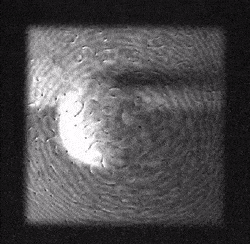LEFT: Schematic of optical setup for optical reconstruction of holographic scenes at various observation angles. Cage system parts are omitted for schematic clarity but serve to keep the collimating condition of the light incident on the metasurface constant for varying swivel angles, θ. RIGHT: Two degrees of freedom enable independent and complete control of the optical amplitude and phase. (a) Schematic of the holographic experiment: circularly polarized light is partially converted by the metasurface to its opposite handedness and is then filtered by an analyzing polarization filter before forming an image on the camera. (b) Geometrical parameters of the meta-atoms sweep the amplitude (black-white gradient axis) and phase (rainbow axis) of the output signal. (c) The meta-atoms in (b) can take incident left circularly polarized light (south pole) to any other point on the Poincaré sphere with near-unity efficiency representing two independent degrees of freedom controlled by the metasurface. (d) Geometric parameters of a meta-atom. (e) Full-wave simulations varying Wy and α for H = 800 nm, Wx = 200 nm, P = 650 nm, and λ = 1.55 μm. The colormap depicts the amplitude, A, of converted light by the saturation and the phase, ϕ, by the hue. (f) “Look-up table” inverting an interpolated version of (e) to specify the values of Wy (saturation) and α (hue) required to achieve a desired A and ϕ. Credit: Light: Science & Applications, doi: 10.1038/s41377-019-0201-7
Metasurfaces are optically thin metamaterials that can control the wavefront of light completely, although they are primarily used to control the phase of light. In a new report, Adam C. Overvig and colleagues in the departments of Applied Physics and Applied Mathematics at the Columbia University and the Center for Functional Nanomaterials at the Brookhaven National Laboratory in New York, U.S., presented a novel study approach, now published on Light: Science & Applications. The simple concept used meta-atoms with a varying degree of form birefringence and angles of rotation to create high-efficiency dielectric metasurfaces with ability to control optical amplitude (maximum extent of a vibration) and phase at one or two frequencies. The work opened applications in computer-generated holography to faithfully reproduce the phase and amplitude of a target holographic scene without using iterative algorithms that are typically required during phase-only holography.
The team demonstrated all-dielectric metasurface holograms with independent and complete control of the amplitude and phase. They used two simultaneous optical frequencies to generate two-dimensional (2-D) and 3-D holograms in the study. The phase-amplitude metasurfaces allowed additional features that could not be attained with phase-only holography. The features included artifact-free 2-D holograms, the ability to encode separate phase and amplitude profiles at the object plane and encode intensity profiles at the metasurface and object planes separately. Using the method, the scientists also controlled the surface textures of 3-D holographic objects.
Light waves possess four key properties including amplitude, phase, polarization and optical impedance. Materials scientists use metamaterials or "metasurfaces" to tune these properties at specific frequencies with subwavelength, spatial resolution. Researchers can also engineer individual structures or "meta-atoms" to facilitate a variety of optical functionalities. Device functionality is presently limited by the ability to control and integrate all four properties of light independently in the lab. Setbacks include challenges of developing individual meta-atoms with varying responses at a desired frequency with a single fabrication protocol. Research studies previously used metallic scatterers due to their strong light-matter interactions to eliminate inherent optical losses relative to metals while using lossless dielectric platforms for high-efficiency phase control—the single most important property for wavefront control. Additional recent efforts have attempted to simultaneously control more than one parameter at a time and form achromatic metasurfaces, dispersion engineered devices and multicolor holograms.
LEFT: Experimental comparison of phase-amplitude (PA, top row), phase-only (PO, middle row), and Gerchberg-Saxton (GS, bottom row) holography. (a–c) The required amplitude and phase across each metasurface, where the saturation of the image corresponds to the amplitude and the hue corresponds to the phase. (d–f) Optical images of fabricated holograms. Scale bars are 150 µm. (g–i) Simulated holographic reconstructions. (j–l) Experimental holographic reconstructions, with counts shown for comparison. RIGHT: Experimental demonstration of depth and parallax in a 3D holographic object. (a) Complex transmission function, τ, of a 3D coil that is 400 × 400 μm in size. (b) Experimental reconstruction of the coil at three depths, showing the 3D nature of the coil. The approximate focal plane positions relative to the metasurface plane and point sources representing the coil are shown for reference. Note that the focal planes are tilted by approximately 15° to the metasurface to reduce spurious back reflections that were present. (c) Reconstruction of the coil at varying observation angles with approximate focal planes for reference, demonstrating parallax. Credit: Light: Science & Applications, doi: 10.1038/s41377-019-0201-7
In the present work, Overvig et al. presented a metasurface platform with arbitrary and simultaneous control of the amplitude and phase using telecommunication frequencies within a transmission type device. They controlled the amplitude by varying the conversion efficiency of circularly polarized light of one-handedness to the opposite handedness (left to right) using structurally birefringent (a ray of light incident on a material is split into two as ordinary and extraordinary rays) meta-atoms, while controlling the phase via in-plane orientation of the meta-atoms. The approach generalized a well-studied meta-surface platform that employed the "geometric" or "Pancharatnam-Berry" phase for the simultaneous control of amplitude and phase.
The approach could be easily generalized to visible frequencies within CMOS compatible dielectric metasurfaces. To demonstrate advantages of the experiment, they compared computer-generated holograms with phase-and-amplitude (PA) metasurfaces and holograms generated with phase-only (PO) metasurfaces to show that only the PA constructs could create artifact-free holographic images. Overvig et al. implemented PA holography to engineer metasurface holograms with high-fidelity to form artistic and complex, three-dimensional (3-D) holographic objects. They created and optimized metasurfaces with two degrees of freedom per pixel to control the amplitude and phase at the object plane. The research team extended the simple scheme to include structural dispersion engineering of meta-atoms and simultaneously control the phase and amplitude of two-color holograms.
TOP: 3D computer-generated holographic objects with controlled surface textures. (a) Schematic depicting the calculation of the complex transmission function, τ, of a metasurface hologram to generate a complex 3D holographic object (a cow). An illuminating beam is scattered by the mesh of the cow and undergoes interference at the plane of the metasurface. (b) τ for the cow with a rough surface texture at the viewing angle shown in (e) and (f). (c) τ for the cow with a rough texture at the viewing angle shown in (g). (d) τ for the cow with a smooth texture at the viewing angle shown in (h). (e) Simulated reconstruction of the cow, showing excellent agreement with f the experimental reconstruction with a diode laser. (g, h) Simulated reconstructions from a different perspective, showing the effect of surface textures on the reconstruction; for the smooth cow in (h), only the specular highlights are apparent. BOTTOM: Controlling the amplitude and phase of holographic images simultaneously. (a, b) Complex transmission functions, τ, of two holograms. (c, d) Simulated reconstructed complex amplitudes, E~, of a, b, yielding holographic images with identical intensity distributions but distinct phase distributions: one has a phase gradient and the other has a uniform phase. (e, f) Experimental holographic reconstructions corresponding to a, b at an observation angle of θ = −20° from the surface normal. (g, h) Experimental holographic reconstructions corresponding to a, b at an observation angle of θ = 0°. The dependence on observation angles is proof that the holographic images have distinct phase gradients, which correspond to distinct far-field projection angles. Credit: Light: Science & Applications, doi: 10.1038/s41377-019-0201-7
Researchers have long-employed the geometric phase approach to spatially vary the phase of light in a process that can be technically implemented by simply altering the orientation of a birefringent material. In this work, the team experimentally varied the degree of birefringence from left circularly polarized light (LCP) to right circularly polarized (RCP) light to independently control the optical amplitude and phase. They also created a meta-atom library and visualized the action it performed using paths along a Poincaré sphere. As a proof-of-concept implementation, the researchers chose an operating wavelength of 1.55 µm and engineered a CMOS-compatible platform of amorphous silicon metasurfaces (α-Si) on fused silica substrates. They then modelled the target meta-atom library using finite-difference time-domain simulations and numerically demonstrated arbitrary control of the amplitude and phase.
For complete experimental control of the amplitude and phase, Overvig et al. implemented computer-generated holograms (CGHs). The first CGH generated a two-dimensional (2-D) holographic image using PA holography with improved image fidelity compared to the versions formed with PO holography. In the second CGH they created a simple, 3-D holographic image containing a collection of points to show the dependence of 3-D holography on the focal plane and the angle of observation. The third CGH demonstrated the faithful reconstruction of a complex 3-D holographic object in the shape of a cow—this indicated the ability to engineer artistically interesting and complex scenes. The team simulated rough or smooth surface textures using a random or uniform distribution of scattered phase on the surface of a cow. The fourth version showed ability to separately encode the phase and amplitude at the object plane to reconstruct a Yin-Yang sign, whereas the fifth CGH encoded a holographic image with the phase distribution of a grayscale hologram of the Columbia crown, the official emblem for Columbia Engineering, Columbia University.
TOP: Two images encoded by a modified Gerchberg-Saxton algorithm allowing a grayscale amplitude at the metasurface plane. (a) Schematic showing the illumination of a metasurface, with an amplitude profile depicting an image of a sphere on a flat surface. The phase profile of the metasurface (not shown) encodes a holographic object (Columbia Engineering logo) at the object plane (3 mm away). (b, f) Target intensity profiles (before blurring) at the metasurface and object planes, respectively. (c, g) Intensity and phase profiles encoded on the metasurface. (d, h) Simulated reconstructions when focused onto the metasurface and object planes, respectively. (e, i) Experimental reconstructions when focused onto the metasurface and object planes, respectively. The metasurface has side lengths of 780 μm, and the logo is ~250 μm across. BOTTOM: Control of the amplitude and phase at two colors simultaneously. a Archetypes of meta-atom cross-sections with many geometric degrees of freedom (each represented by a double-sided arrow) degenerately cover the “phase-dispersion” space of the propagation phase. (b) Visualization of the coverage of (AR,AB,ϕR,ϕB) by the meta-atoms in (a) with bins of 10% amplitude and circular polarization that is opposite for each color. (c) Complex transmission function of a two-color hologram for the red wavelength (λRed=1.65μm). (d) Complex transmission function of the two-color hologram for the blue wavelength (λBlue=0.94μm). (e) Scanning electron micrograph (SEM) of an example hologram, showing many instances of the archetypes from a with variable in-plane orientation angles. Scale bar is 3 μm. (f) SEM with (a) perspective view of the 1 μm-tall pillars in (e). Scale bar is 2 μm. g Target two-color image. h Experimental reconstruction overlaying the separately measured pictures at the red wavelength shown in i and at the blue wavelength shown in (j). Credit: Light: Science & Applications, doi: 10.1038/s41377-019-0201-7
During reconstruction of the Columbia Engineering logo to generate a 2-D CGH, the team discretized a target image into dipole sources with amplitudes of one (area inside the logo) and zero (the background) and a uniform phase. They recorded the interference of these dipole sources from the target image to a specific distance (750 μm), which corresponded to the location of the metasurface to reconstruct the target image. When reconstructing the second PO hologram of the Columbia crown, Overvig et al. used an alternate approach known as the Gerchberg-Saxton (GS) algorithm to generate the desired intensity distribution of the target image. They did not require similar iterations with PA holography, which allowed them to faithfully reproduce both phase and amplitude of the desired hologram. The researchers reconstructed each holographic image using numerical simulations and experiments and observed improved image quality in the PA hologram compared to PO or GS holograms.
PA holography also allowed the scientists to control the amplitude profiles of two separate planes rather than the amplitude and phase at a single plane. They produced holographic images and showed good agreement between experimental reconstructions and simulations. The scientists extended the simple approach to control the phase and amplitude independently at two separate wavelengths. Wherein they simultaneously controlled four wavefront parameters at each meta-atom, which experimentally required more than two degrees of freedom. The team extended past efforts to include birefringence during meta-atom design to expansively control the phase response of the ordinary and extraordinary polarizations (birefringence) of the two wavelengths.
Video shows the transformation between the reconstructed images as the focal plane of the imaging setup is adjusted between the hologram and the object planes to form the object of interest. Credit: Light: Science & Applications, doi: 10.1038/s41377-019-0201-7
After they used scanning electron micrographs to observe the fabricated devices, they acquired two-color experimental reconstructions by aligning LCP excitation at a wavelength of 1.65 µm (red channel) and an RCP excitation at a wavelength of 0.94 µm (blue channel). The number of meta-atoms that required simulation approximated 60,000 in the study, which represented a daunting computational task for accuracy any higher than that presently achieved. Overvig et al. therefore restricted the study to the present imperfect but computationally manageable solution.
In this way, Adam C. Overvig and an interdisciplinary research team demonstrated metasurface holograms using low-loss dielectric metasurfaces. They operated the constructs in transmission mode with complete and independent phase and amplitude control at one and two wavelengths, employing a simple but powerful design principle to open a degree of control across optical wavelengths useful for many applications. The work offers a robust and broadly applicable method to manipulate an optical wavefront at will and thereby realize the primary promise of metasurfaces.
More information: Adam C. Overvig et al. Dielectric metasurfaces for complete and independent control of the optical amplitude and phase, Light: Science & Applications (2019). DOI: 10.1038/s41377-019-0201-7 N.
Yu et al. Light Propagation with Phase Discontinuities: Generalized Laws of Reflection and Refraction, Science (2011). DOI: 10.1126/science.1210713
Amir Arbabi et al. Dielectric metasurfaces for complete control of phase and polarization with subwavelength spatial resolution and high transmission, Nature Nanotechnology (2015). DOI: 10.1038/nnano.2015.186
Journal information: Science , Light: Science & Applications , Nature Nanotechnology
© 2019 Science X Network




























